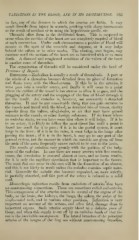Page 673 - My FlipBook
P. 673
VARIATIONS IN THE BLOOD, AND IN ITS DISTRIBUTION. 683
in fact, any of the diseases to which the arteries are liable. It may
result directly from injury in wounds, pricking with sharp instruments
as the result of accident or in using the hypodermic needle, etc.
Thrombi often form in the debilitated heart. This is supposed to
occur when the cavities of the heart are not completely emptied of blood
at each contraction. Under such circumstances a portion of blood will
remain in the apex of the ventricle and stagnate, or it may lodge
behind the valves or in other nooks. The clotting, once begun, may
continue until the motions of the heart are so interfered with as to cause
death. A diseased and roughened condition of the valves of the heart
is another cause of thrombus.
The organization of thrombi will be considered under the head of
Processes of Repair.
Embolism.—Embolism is usually a result of thrombosis. A part or
the whole of a thrombus becomes detached from its place of formation
and floats away with the blood-stream. If this be in the arteries, it
must pass into a smaller artery, and finally it will come to a point
where the calibre of the vessel is too narrow to allow it to pass, and the
plugging of the artery and the stoppage of the flow of blood through it
are the result. An embolus is, however, not necessarily a detached
thrombus. It may be any conceivable thing that can gain entrance to
the vessels and travel with the blood, as detached bits of tumor, chalky
deposits from the valves, oil-globules, or air that may have gained
entrance to the vessels, or other foreign substance. If we know Avhere
an embolus starts, we can have some idea where it will lodge. If it be
in an artery, it is likely to follow the most direct line until a point is
found too small for it to pass ; if it is in the portal system, it must
lodge in the liver ; if it is in the veins, it must lodge in the lungs after
passing the heart ; if it is in the heart, it may go to any part of the
general system, but the manner in which the carotids are given oif from
the arch of the aorta frequently causes emboli to be sent to the brain.
The results of einbollsiii vary greatly with the position of the lodg-
ment of the embolus. In case there are many arteries with free anasto-
moses, the circulation is restored almost at once, and no harm results,
for it is only the capillary circulation that is important to the tissues.
The most that can occur in this case will be the formation of an abscess,
and this is not likely to result unless the embolus contains septic mate-
rial. Generally the embolic clot becomes organized, or, more strictly,
is partially absorbed, and this part of the artery is reduced to a solid
Hemorrharjic infarction results from embolism of arteries that have
no anastomosing connections. These are sometimes called end-arteries.
This arrangement of the arteries occurs in several of the organs of the
body, as the brain, the kidneys, the lungs, the spleen, the pulps of the
single-rooted teeth, and in various other positions. Infarction is very
important on account of the serious, and often fatal, damage clone to
important organs. Such arteries supply blood to a definite piece of
tissue, and when this supply is cut off* by an embolus death of that tis-
sue is the inevitable consequence. The lateral branches of the principal
arteries of the tongue of the frog are without anastomosing branches,


